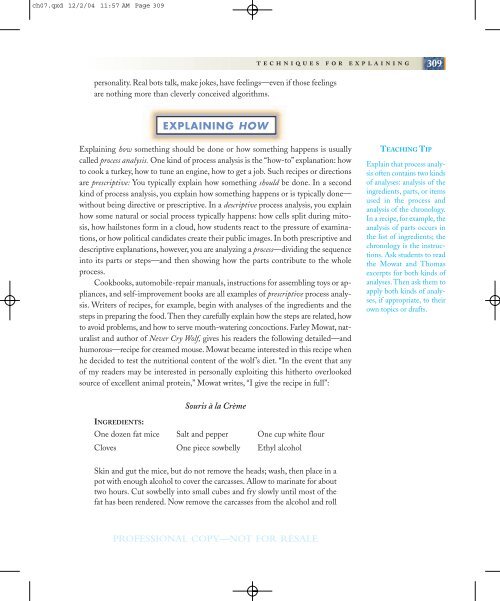A prolific painter of portraits before and after the French Revolution ...
A prolific painter of portraits before and after the French Revolution ...
A prolific painter of portraits before and after the French Revolution ...
You also want an ePaper? Increase the reach of your titles
YUMPU automatically turns print PDFs into web optimized ePapers that Google loves.
ch07.qxd 12/2/04 11:57 AM Page 309<br />
techniques for explaining<br />
309<br />
personality. Real bots talk, make jokes, have feelings—even if those feelings<br />
are nothing more than cleverly conceived algorithms.<br />
EXPLAINING HOW<br />
Explaining how something should be done or how something happens is usually<br />
called process analysis. One kind <strong>of</strong> process analysis is <strong>the</strong> “how-to” explanation: how<br />
to cook a turkey, how to tune an engine, how to get a job. Such recipes or directions<br />
are prescriptive: You typically explain how something should be done. In a second<br />
kind <strong>of</strong> process analysis, you explain how something happens or is typically done—<br />
without being directive or prescriptive. In a descriptive process analysis, you explain<br />
how some natural or social process typically happens: how cells split during mitosis,<br />
how hailstones form in a cloud, how students react to <strong>the</strong> pressure <strong>of</strong> examinations,<br />
or how political c<strong>and</strong>idates create <strong>the</strong>ir public images. In both prescriptive <strong>and</strong><br />
descriptive explanations, however, you are analyzing a process—dividing <strong>the</strong> sequence<br />
into its parts or steps—<strong>and</strong> <strong>the</strong>n showing how <strong>the</strong> parts contribute to <strong>the</strong> whole<br />
process.<br />
Cookbooks, automobile-repair manuals, instructions for assembling toys or appliances,<br />
<strong>and</strong> self-improvement books are all examples <strong>of</strong> prescriptive process analysis.<br />
Writers <strong>of</strong> recipes, for example, begin with analyses <strong>of</strong> <strong>the</strong> ingredients <strong>and</strong> <strong>the</strong><br />
steps in preparing <strong>the</strong> food. Then <strong>the</strong>y carefully explain how <strong>the</strong> steps are related, how<br />
to avoid problems, <strong>and</strong> how to serve mouth-watering concoctions. Farley Mowat, naturalist<br />
<strong>and</strong> author <strong>of</strong> Never Cry Wolf, gives his readers <strong>the</strong> following detailed—<strong>and</strong><br />
humorous—recipe for creamed mouse. Mowat became interested in this recipe when<br />
he decided to test <strong>the</strong> nutritional content <strong>of</strong> <strong>the</strong> wolf ’s diet. “In <strong>the</strong> event that any<br />
<strong>of</strong> my readers may be interested in personally exploiting this hi<strong>the</strong>rto overlooked<br />
source <strong>of</strong> excellent animal protein,” Mowat writes, “I give <strong>the</strong> recipe in full”:<br />
TEACHING TIP<br />
Explain that process analysis<br />
<strong>of</strong>ten contains two kinds<br />
<strong>of</strong> analyses: analysis <strong>of</strong> <strong>the</strong><br />
ingredients, parts, or items<br />
used in <strong>the</strong> process <strong>and</strong><br />
analysis <strong>of</strong> <strong>the</strong> chronology.<br />
In a recipe, for example, <strong>the</strong><br />
analysis <strong>of</strong> parts occurs in<br />
<strong>the</strong> list <strong>of</strong> ingredients; <strong>the</strong><br />
chronology is <strong>the</strong> instructions.<br />
Ask students to read<br />
<strong>the</strong> Mowat <strong>and</strong> Thomas<br />
excerpts for both kinds <strong>of</strong><br />
analyses. Then ask <strong>the</strong>m to<br />
apply both kinds <strong>of</strong> analyses,<br />
if appropriate, to <strong>the</strong>ir<br />
own topics or drafts.<br />
INGREDIENTS:<br />
Souris à la Crème<br />
One dozen fat mice Salt <strong>and</strong> pepper One cup white flour<br />
Cloves One piece sowbelly Ethyl alcohol<br />
Skin <strong>and</strong> gut <strong>the</strong> mice, but do not remove <strong>the</strong> heads; wash, <strong>the</strong>n place in a<br />
pot with enough alcohol to cover <strong>the</strong> carcasses. Allow to marinate for about<br />
two hours. Cut sowbelly into small cubes <strong>and</strong> fry slowly until most <strong>of</strong> <strong>the</strong><br />
fat has been rendered. Now remove <strong>the</strong> carcasses from <strong>the</strong> alcohol <strong>and</strong> roll<br />
PROFESSIONAL COPY—NOT FOR RESALE

















